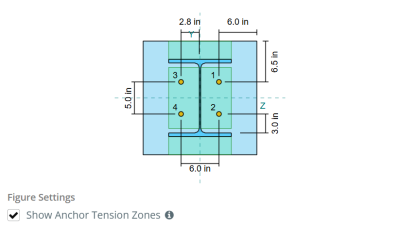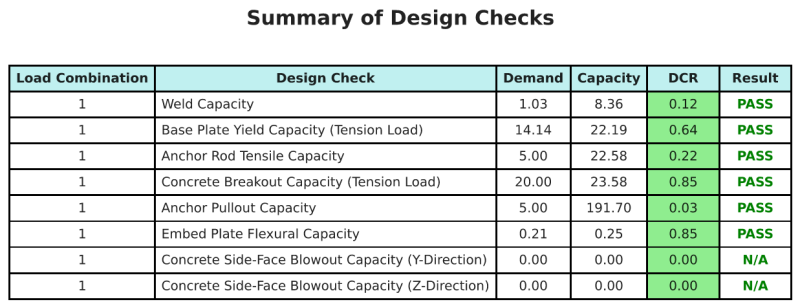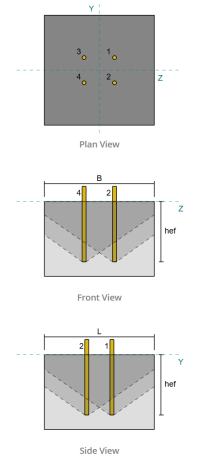Basisplatten -Designbeispiel unter Verwendung von AISC 360-22 und ACI 318-19

Problemanweisung
Determine whether the designed column-to-base plate connection is sufficient for a 20-kip tension load.
Gegebene Daten
Spalte:
Spaltenabschnitt: W12x53
Säulenbereich: 15.6 im2
Säulenmaterial: A992
Grundplatte:
Grundplattenabmessungen: 18 in x 18 im
Grundplattendicke: 3/4 im
Grundplattenmaterial: A36
Fugenmörtel:
Fugenmörtel Dicke: 1 im
Beton:
Konkrete Abmessungen: 22 in x 22 im
Betondicke: 15 im
Betonmaterial: 4000 psi
Geknackt oder ungekrönt: Geknackt
Anker:
Ankerdurchmesser: 3/4 im
Effektive Einbettungslänge: 12 im
Einbettungsplattenbreite: 3 im
Dicke eingebetteter Platten: 1/4 im
Anchor offset distance from face of column web: 2.8275 im
Schweißnähte:
Schweißnahtgröße: 1/4 im
Füllmetallklassifizierung: E70XX
Ankerdaten (von Skyciv -Taschenrechner):

Modell im kostenlosen SkyCiv-Tool
Modellieren Sie noch heute das oben stehende Grundplattendesign mit unserem kostenlosen Online-Tool! Keine Anmeldung erforderlich.
Definitionen
Lastpfad:
Wenn eine Grundplatte einer Auftriebsausgabe ausgesetzt ist (zugfest) Kräfte, Diese Kräfte werden auf die Ankerstangen übertragen, was wiederum Biege Momente in der Grundplatte hervorruft. Die Biegeaktion kann als visualisiert werden als Beuge des Auslegers Um die Flansche oder das Netz des Spaltenabschnitts auftreten, abhängig davon, wo die Anker positioniert sind.
In dem SkyCiv Basisplatten-Design-Software, Nur Anker innerhalb der Ankerspannungszone werden als wirksam angesehen, um die Häufigkeit zu widerstehen. Diese Zone enthält typischerweise Bereiche in der Nähe der Spaltenflansche oder des Netzes. Anker außerhalb dieser Zone tragen nicht zum Spannungswiderstand bei und sind von den Anhebungsberechnungen ausgeschlossen.

Um den effektiven Bereich der Grundplatte zu bestimmen, der sich der Biegung widersetzt, ein 45-Gradispersion wird von der Mittellinie jeder Ankerstange in Richtung der Säulenfläche angenommen. Diese Dispersion definiert die effektive Schweißlänge und hilft, die zu etablieren Effektive Biegebreite der Platte.
Die Annahme vereinfacht die Grundplattenanalyse, indem sie sich annähert, wie sich die Erhöhungskraft durch die Platte ausbreitet.
Ankergruppen:
Mit der SkyCiv Basisplatten-Design-Software Enthält eine intuitive Funktion, die identifiziert, welche Anker Teil einer Ankergruppe für die Bewertung sind Betonausbruch und concrete side-face blowout Fehler.
Ein Ankergruppe besteht aus mehreren Ankern mit ähnlichen effektiven Einbettungstiefen und Abstand, und sind nah genug, dass ihre Projizierte Widerstandsbereiche überlappen sich. Wenn Anker gruppiert sind, Ihre Kapazitäten werden kombiniert, um der Gesamtspannungskraft zu widerstehen, die der Gruppe angewendet wird.
Anker, die die Gruppierungskriterien nicht erfüllen, werden als behandelt einzelne Anker. In diesem Fall, Nur die Spannungskraft am individuellen Anker wird gegen seinen eigenen wirksamen Widerstandsbereich überprüft.
Schritt-für-Schritt-Berechnungen
Prüfen #1: Berechnen Sie die Schweißkapazität
Anwenden seismischer Lasten, Wir müssen die Last pro Anker und die effektive Schweißlänge pro Anker berechnen. The effective weld length is determined by the shortest length from the 45° dispersion, eingeschränkt durch die tatsächliche Schweißlänge und den Ankerabstand.
Für diese Berechnung, Anker werden als beide klassifiziert Endanker oder Zwischenanker. Die Endanker befinden sich an den Enden einer Reihe oder einer Säule der Anker, während Zwischenanker zwischen ihnen positioniert sind. Die Berechnungsmethode unterscheidet sich jeweils und hängt von der Säulengeometrie ab. In diesem Beispiel, Es gibt zwei Anker im Internet, und beide werden als Endanker eingestuft.

Für Endanker, the effective weld length is limited by the available distance from the anchor centerline to the column fillet. Die 45 ° Dispersion darf sich nicht über diese Grenze hinaus erstrecken.
\(
l_r = frac{d_{col} – 2t_f – 2r_{col} – S_(N_{ein,Seite} – 1)}{2} = frac{12.1 \, \Text{im} – 2 \mal 0.575 \, \Text{im} – 2 \mal 0.605 \, \Text{im} – 5 \, \Text{im} \mal (2 – 1)}{2} = 2.37 \, \Text{im}
\)
Auf der inneren Seite, Die effektive Länge ist um die Hälfte des Ankerabstands begrenzt. Die insgesamt effektive Schweißlänge für den Endanker ist die Summe der äußeren und inneren Längen.
\(
l_{eff,Ende} = min(Tun, 0.5S_) + \Min.(Tun, l_r)
\)
\(
l_{eff,Ende} = min(2.8275 \, \Text{im}, 0.5 \mal 5 \, \Text{im}) + \Min.(2.8275 \, \Text{im}, 2.37 \, \Text{im}) = 4.87 \, \Text{im}
\)
Für dieses Beispiel, bleibt die final effective weld length for the web anchor is taken as the effective length of the end anchor.
\(
l_{eff} = l_{eff,Ende} = 4.87 \, \Text{im}
\)
Als nächstes, Berechnen wir die Last pro Anker. Für einen bestimmten Satz von vier (4) Anker, Die Last pro Anker ist:
\(
T_{u,Anker} = frac{N_x}{N_{ein,t}} = frac{20 \, \Text{kip}}{4} = 5 \, \Text{kip}
\)
Unter Verwendung der berechneten effektiven Schweißlänge, we can now determine the required force per unit length on the weld.
\(
r_u = frac{T_{u,Anker}}{l_{eff}} = frac{5 \, \Text{kip}}{4.87 \, \Text{im}} = 1.0267 \, \Text{kip/in}
\)
Jetzt, wir werden verwenden AISC 360-22, Chapter J2.4 Berechnung der Entwurfsstärke der Filetschweißung.
Since the applied load is purely axial tension, the angle \(\theta\) is taken as 90°, and the directional strength coefficient kds is calculated according to AISC 360-22 Gl. J2-5.
\(
k_{ds} = 1.0 + 0.5(\ohne(\theta))^{1.5} = 1 + 0.5 \mal (\ohne(1.5708))^{1.5} = 1.5
\)
Schließlich, Wir werden uns bewerben AISC 360-22 Gl. J2-4 zu bestimmen design strength of the fillet weld per unit length.
\(
\phi r_n = phi 0.6 F_{Exx} E_{w,Netz} k_{ds} = 0.75 \mal 0.6 \mal 70 \, \Text{KSI} \mal 0.177 \, \Text{im} \mal 1.5 = 8.3633 \, \Text{kip/in}
\)
Schon seit 1.0267 KPI < 8.3633 KPI, Die Schweißkapazität ist ausreichend.
Prüfen #2: Berechnen Sie die Kapazität der Grundplattenflexus aufgrund der Spannungsbelastung
Using the load per anchor and the offset distance from the center of the anchor to the face of the column (Als Lastzentrizität dienen), Der auf die Grundplatte angewendete Moment kann mit a berechnet werden Ausleger Annahme.
\(
M_u = T_{u,\Text{Anker}} e = 5 \, \Text{kip} \mal 2.8275 \, \Text{im} = 14.137 \, \Text{kip} \CDOT Text{im}
\)
Als nächstes, using the calculated effective weld length from the previous check as the bending width, Wir können die berechnen SkyCiv Foundation ist ein Designmodul für die Gestaltung von Spreizfundamenten aus den Überbaulasten der Grundplatte verwenden AISC 360-22, Gleichung 2-1:
\(
\phi M_n = \phi F_{j,\Text{bp}} Z_{\Text{eff}} = 0.9 \mal 36 \, \Text{KSI} \mal 0.68484 \, \Text{im}^3 = 22.189 \, \Text{kip} \CDOT Text{im}
\)
Wo,
\(
Z_{\Text{eff}} = frac{l_{\Text{eff}} (t_{\Text{bp}})^ 2}{4} = frac{4.87 \, \Text{im} \mal (0.75 \, \Text{im})^ 2}{4} = 0.68484 \, \Text{im}^ 3
\)
Schon seit 14.137 Hühnchen < 22.189 Hühnchen, Die Grundkapazität der Grundplattenbiegung ist ausreichend.
Prüfen #3: Berechnen Sie die Ankerstange Zugkapazität
Bewertung der Zugkapazität der Ankerstange, wir werden verwenden ACI 318-19 Gleichung 17.6.1.2.
Zuerst, Wir bestimmen die angegebene Zugfestigkeit des Ankerstahls. Dies ist der niedrigste Wert, der von erlaubt ist ACI 318-19 Klausel 17.6.1.2, with reference to material properties in AISC 360-22 Tabelle J3.2.
\(
f_{\Text{uta}} = min links( 0.75 F_{u,\Text{anc}}, 1.9 F_{j,\Text{anc}}, 125 \richtig) = min links( 0.75 \mal 120 \, \Text{KSI}, 1.9 \mal 92 \, \Text{KSI}, 125.00 \, \Text{KSI} \richtig) = 90 \, \Text{KSI}
\)
Als nächstes, wir berechnen die Wirksamer Querschnittsbereich der Ankerstange. This is based on ACI 318-19 Commentary Clause R17.6.1.2, which accounts for thread geometry. The number of threads per inch is taken from ASME B1.1-2019 Table 1.
\(
EIN_{ich weiß,N.} = frac{\Pi}{4} \links( d_a – \frac{0.9743}{n_t} \richtig)^2 = Frac{\Pi}{4} \mal links( 0.75 \, \Text{im} – \frac{0.9743}{10 \, \Text{im}^{-1}} \richtig)^2 = 0.33446 \, \Text{im}^ 2
\)
Mit diesen Werten, Wir bewerben uns ACI 318-19 Gleichung 17.6.1.2 um die zu berechnen design tensile strength der Ankerstange.
\(
\phi N_{zu} = phiA_{ich weiß,N.} f_{\Text{uta}} = 0.75 \mal 0.33446 \, \Text{im}^2 mal 90 \, \Text{KSI} = 22.576 \, \Text{kip}
\)
Erinnern Sie sich an die zuvor berechneten Spannungsbelastung pro Anker:
\(
N_{Tun} = frac{N_x}{N_{ein,t}} = frac{20 \, \Text{kip}}{4} = 5 \, \Text{kip}
\)
Schon seit 5 kip < 22.576 kip, Die Ankerstange -Zugkapazität ist ausreichend.
Prüfen #4: Berechnen Sie die Betonausbruchkapazität in der Spannung

Vor der Berechnung der Ausbruchkapazität, Wir müssen zuerst feststellen, ob das Mitglied als qualifiziert ist enges Mitglied. Gemäß ACI 318-19 Klausel 17.6.2.1.2, Das Mitglied erfüllt die Kriterien für ein enges Mitglied. Deshalb, a modified effective embedment length must be used in the calculations.
It is determined that the modifizierte effektive Einbettungslänge, h’ef, der Ankergruppe ist:
\(
H'_{\Text{ef}} = 5.667 \, \Text{im}
\)
Verwenden von ACI 318-19 Klausel 17.6.2, wir berechnen die Maximal projizierter Betonkegelbereich für einen einzelnen Anker, based on the modified effective embedment length.
\(
EIN_{N_{co}} = 9 \links( H'_{ef,G1} \richtig)^2 = 9 \mal links( 5.6667 \, \Text{im} \richtig)^2 = 289 \, \Text{im}^ 2
\)
Ähnlich, we use the modified effective embedment length to calculate the Tatsächlicher projizierter Betonkegelbereich der Ankergruppe.
\(
EIN_{N_c} = min links( N_{ein,G1} EIN_{N_{co}}, L_{N_c} B_{N_c} \richtig) = min links( 4 \mal 289 \, \Text{im}^ 2, 22 \, \Text{im} \mal 22 \, \Text{im} \richtig) = 484 \, \Text{im}^ 2
\)
Wo,
\(
L_{N_c} = min links( c_{\Text{links},G1}, 1.5 H'_{\Text{ef},G1} \richtig)
+ \links( \min links( S_{\Text{Summe},mit,G1}, 3 H'_{\Text{ef},G1} \links( N_{mit,G1} – 1 \richtig) \richtig) \richtig)
+ \min links( c_{\Text{richtig},G1}, 1.5 H'_{\Text{ef},G1} \richtig)
\)
\(
L_{N_c} = min links( 8 \, \Text{im}, 1.5 \mal 5.6667 \, \Text{im} \richtig)
+ \links( \min links( 6 \, \Text{im}, 3 \mal 5.6667 \, \Text{im} \mal links( 2 – 1 \richtig) \richtig) \richtig)
+ \min links( 8 \, \Text{im}, 1.5 \mal 5.6667 \, \Text{im} \richtig)
\)
\(
L_{N_c} = 22 \, \Text{im}
\)
\(
B_{N_c} = min links( c_{\Text{oben},G1}, 1.5 H'_{\Text{ef},G1} \richtig)
+ \links( \min links( S_{\Text{Summe},j,G1}, 3 H'_{\Text{ef},G1} \links( N_{j,G1} – 1 \richtig) \richtig) \richtig)
+ \min links( c_{\Text{Unterseite},G1}, 1.5 H'_{\Text{ef},G1} \richtig)
\)
\(
B_{N_c} = min links( 8.5 \, \Text{im}, 1.5 \mal 5.6667 \, \Text{im} \richtig)
+ \links( \min links( 5 \, \Text{im}, 3 \mal 5.6667 \, \Text{im} \mal links( 2 – 1 \richtig) \richtig) \richtig)
+ \min links( 8.5 \, \Text{im}, 1.5 \mal 5.6667 \, \Text{im} \richtig)
\)
\(
B_{N_c} = 22 \, \Text{im}
\)
Als nächstes, Wir bewerten die basic concrete breakout strength eines einzelnen Ankers verwenden ACI 318-19 Klausel 17.6.2.2.1
\(
N_b = k_c lambda_a sqrt{\frac{f’_c}{\Text{psi}}} \links( \frac{H'_{\Text{ef},G1}}{\Text{im}} \richtig)^{1.5} \, \Text{lbf}
\)
\(
N_b = 24 \mal 1 \mal sqrt{\frac{4 \, \Text{KSI}}{0.001 \, \Text{KSI}}} \mal links( \frac{5.6667 \, \Text{im}}{1 \, \Text{im}} \richtig)^{1.5} \mal 0.001 \, \Text{kip} = 20.475 \, \Text{kip}
\)
Wo,
- \(k_{c} = 24\) für einbetonierte Anker
- \(\lambda = 1.0 \) Für Normalgewicht Beton
Jetzt, Wir bewerten die Auswirkungen der Geometrie, indem wir die berechnen Kanteneffektfaktor und das Exzentrizitätsfaktor.
Der kürzeste Randabstand der Ankergruppe wird als bestimmt als:
\(
c_{ein,\Text{Min.}} = min links( c_{\Text{links},G1}, c_{\Text{richtig},G1}, c_{\Text{oben},G1}, c_{\Text{Unterseite},G1} \richtig)
= min links( 8 \, \Text{im}, 8 \, \Text{im}, 8.5 \, \Text{im}, 8.5 \, \Text{im} \richtig) = 8 \, \Text{im}
\)
Gemäß ACI 318-19 Klausel 17.6.2.4.1, der Ausbruch Kanteneffektfaktor ist:
\(
\Psi_{ed,N.} = min links( 1.0, 0.7 + 0.3 \links( \frac{c_{ein,\Text{Min.}}}{1.5 H'_{\Text{ef},G1}} \richtig) \richtig)
= min links( 1, 0.7 + 0.3 \mal links( \frac{8 \, \Text{im}}{1.5 \mal 5.6667 \, \Text{im}} \richtig) \richtig) = 0.98235
\)
Since the tension load is applied at the centroid of the anchor group, the eccentricity is zero. So, bleibt die Exzentrizitätsfaktor, also from Clause 17.6.2.4.1, ist:
\(
\Psi_{ec,N.} = min links( 1.0, \frac{1}{1 + \frac{2 und’_N}{3 H'_{\Text{ef},G1}}} \richtig)
= min links( 1, \frac{1}{1 + \frac{2 \mal 0}{3 \mal 5.6667 \, \Text{im}}} \richtig) = 1
\)
Zusätzlich, beide Rissfaktor und das Spaltfaktor werden als:
\(
\Psi_{c,N.} = 1
\)
\(
\Psi_{cp,N.} = 1
\)
Dann, Wir kombinieren all diese Faktoren und verwenden ACI 318-19 Gl. 17.6.2.1b Um die zu bewerten concrete breakout strength of the anchor group:
\(
\phi N_{cbg} = phi links( \frac{EIN_{N_c}}{EIN_{N_{co}}} \richtig) \Psi_{ec,N.} \Psi_{ed,N.} \Psi_{c,N.} \Psi_{cp,N.} N_b
\)
\(
\phi N_{cbg} = 0.7 \mal links( \frac{484 \, \Text{im}^ 2}{289 \, \Text{im}^ 2} \richtig) \mal 1 \mal 0.98235 \mal 1 \mal 1 \mal 20.475 \, \Text{kip} = 23.58 \, \Text{kip}
\)
Mit der Gesamtspannungsbelastung on the anchor group is the product of the individual anchor load and the number of anchors:
\(
N_{Tun} = left( \frac{N_x}{N_{ein,t}} \richtig) N_{ein,G1} = left( \frac{20 \, \Text{kip}}{4} \richtig) \mal 4 = 20 \, \Text{kip}
\)
Schon seit 20 Kips < 23.58 Kips, Die Betonausbruchkapazität ist ausreichend.
Prüfen #5: Berechnen Sie die Ankerauszugskapazität
Die Ausziehkapazität eines Ankers wird durch den Widerstand an seinem eingebetteten Ende bestimmt. Anwenden seismischer Lasten, we calculate the bearing area of the embedded plate, Dies ist die Nettofläche nach Abzug der von der Ankerstange eingenommenen Fläche.
For a rectangular embedded plate, bleibt die Lagerfläche wird berechnet als:
\(
EIN_{brg} = left( \links( = Abstand des Abschnitts, in dem die Scherung berücksichtigt wird, zur Fläche des nächsten Auflagers{einbetten _plate} \richtig)^2 rechts) – EIN_{Stange} = left( \links( 3 \, \Text{im} \richtig)^2 rechts) – 0.44179 \, \Text{im}^2 = 8.5582 \, \Text{im}^ 2
\)
Wo,
\(
EIN_{Stange} = frac{\Pi}{4} \links( d_a rechts)^2 = Frac{\Pi}{4} \mal links( 0.75 \, \Text{im} \richtig)^2 = 0.44179 \, \Text{im}^ 2
\)
Als nächstes, Wir bestimmen die basic anchor pullout strength mit ACI 318-19 Equation 17.6.3.2.2a.
\(
N_b = 8 EIN_{brg} \links( f'_c rechts) = 8 \mal 8.5582 \, \Text{im}^2 Times links( 4 \, \Text{KSI} \richtig) = 273.86 \, \Text{kip}
\)
We then apply the appropriate resistance factor and pullout cracking factor:
- Zum cracked Beton, \(\Psi_{cp} = 1.0\)
- Zum uncracked Beton, \(\Psi_{cp} = 1.4\)
Using these, Wir berechnen die design anchor pullout strength in tension pro ACI 318-19 Gleichung 17.6.3.1.
\(
\phi N_{pn} = \phi \Psi_{c,p} N_b = 0.7 \mal 1 \mal 273.86 \, \Text{kip} = 191.7 \, \Text{kip}
\)
Erinnern Sie sich an die zuvor berechneten Spannungsbelastung pro Anker:
\(
N_{Tun} = frac{N_x}{N_{ein,t}} = frac{20 \, \Text{kip}}{4} = 5 \, \Text{kip}
\)
Schon seit 5 Kips < 191.7 Kips, Die Ankerauszugskapazität ist ausreichend.
Prüfen #6: Berechnen Sie die Biegekapazität der Einbettplatte
This is a supplementary check performed using the Skyciv Base Plate Design Software to verify that the embedded plate has sufficient flexural capacity and will not yield under the applied pullout loads.
Zuerst, we determine the length of the free (unsupported) end of the embedded plate, measured from the edge of the support to the face of the rod.
\(
b’ = frac{= Abstand des Abschnitts, in dem die Scherung berücksichtigt wird, zur Fläche des nächsten Auflagers{einbetten _plate} – d_a}{2} = frac{3 \, \Text{im} – 0.75 \, \Text{im}}{2} = 1.125 \, \Text{im}
\)
Als nächstes, wir berechnen die Biegemoment induced by the uniform bearing pressure. This pressure represents the force transferred from the anchor pullout action onto the embedded plate.
\(
m_f = \frac{\links( \frac{T_a}{EIN_{brg}} \richtig) \links( b’ \richtig)^ 2}{2} = frac{\links( \frac{5 \, \Text{kip}}{8.5582 \, \Text{im}^ 2} \richtig) \mal links( 1.125 \, \Text{im} \richtig)^ 2}{2} = 0.36971 \, \Text{kip}
\)
Schließlich, using the calculated moment and given material properties, we will determine the minimum required plate thickness to resist flexural yielding.
\(
t_{Min.} = Quadrat{\frac{4 m_f}{\PHI F_{y\_ep}}} = Quadrat{\frac{4 \mal 0.36971 \, \Text{kip}}{0.9 \mal 36 \, \Text{KSI}}} = 0.21364 \, \Text{im}
\)
Recall actual embedded plate thickness:
\(
t_{actual} = t_{einbetten _plate} = 0.25 \, \Text{im}
\)
Schon seit 0.21364 im < 0.25 im, the embedded plate flexural capacity is ausreichend.
Prüfen #7: Berechnen Sie die Blowout-Kapazität der Seitengesicht in der y-Richtung
This calculation is not applicable for this example, as the conditions specified in ACI 318-19 Klausel 17.6.4 are not met. Deshalb, side-face blowout failure along the Y-direction will not occur.
Prüfen #8: Berechnen Sie die Blowout-Kapazität der Seitengesicht in der Z-Richtung
This calculation is not applicable for this example, as the conditions specified in ACI 318-19 Klausel 17.6.4 are not met. Deshalb, side-face blowout failure along the Z-direction will not occur.
Entwurfszusammenfassung
Mit der Skyciv Base Plate Design Software kann automatisch einen Schritt-für-Schritt-Berechnungsbericht für dieses Entwurfsbeispiel erstellen. Es enthält auch eine Zusammenfassung der durchgeführten Schecks und deren resultierenden Verhältnisse, Die Informationen auf einen Blick leicht zu verstehen machen. Im Folgenden finden Sie eine Stichprobenzusammenfassungstabelle, Welches ist im Bericht enthalten.

SKYCIV -Beispielbericht
Sehen Sie sich den Detaillierungsgrad und die Klarheit an, die Sie von einem SkyCiv-Grundplatten-Designbericht erwarten können. Der Bericht umfasst alle wichtigen Designprüfungen, Gleichungen, und Ergebnisse werden in einem klaren und leicht lesbaren Format präsentiert. Es entspricht vollständig den Designstandards. Klicken Sie unten, um einen Beispielbericht anzuzeigen, der mit dem SkyCiv-Grundplattenrechner erstellt wurde.
Basisplattensoftware kaufen
Kaufen Sie die Vollversion des Basisplatten -Designmoduls selbst ohne andere Skyciv -Module selbst. Auf diese Weise erhalten Sie einen vollständigen Satz von Ergebnissen für die Basisplattendesign, Einbeziehung detaillierter Berichte und mehr Funktionen.



